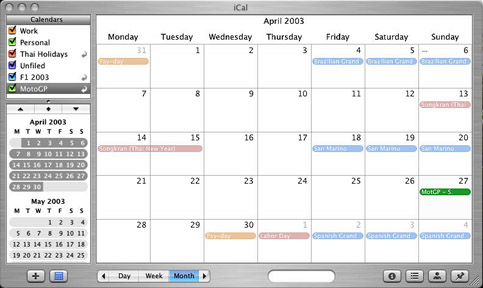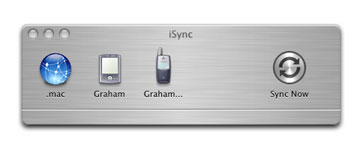
eXtensions
|
More iToys |
Note: The second paragraph may give the impression that I reviewed iPhoto in the Bangkok Post, although visiting the link given will show that I am taking a look at iTunes, with just a passing mention of iPhoto. My apologies
At the end of February, new versions of iMovie and iPhoto were released. These, with iDVD, make up the software package, known as iLife. Although there is a charge for this, it is really only for iDVD as the other applications are available for free download. However, at 33MB and 80Mb, I have better things to do with my on-line time. The earlier versions I have will have to do for now.
I examined iPhoto earlier in February. Other applications from Apple with the i-prefix include iChat, iCal and iSync.
iChat
One of the major attractions to younger users of the Internet has been the ability to interact with others who have common interests, via chat programs such as IRC and Pirch. I think the last time I was in direct, one to one, communication on the Internet, I used the UNIX command, "talk" (still available) some five years ago.
There are two ways to use iChat: as a member of .Mac (formerly iTools); or as a user of AIM (AOL Instant Messenger). While iTools used to be free and became a pay-for service some months ago, AIM does not (currently) require a user to have an AOL account.
When conmected to the Internet, I can link with other users worldwide whose details I have entered into my "Buddy List": these can also be entered into the Address Book. If it were simply a restricted chat service, it would not have much mileage at all in terms of connectivity. There are interest groups within the AIM and .Mac communities, including a Mac group, so there is wider value.
However, in addition to text exchange, it is also possible to transmit images: in the setup procedure for example, you have the option to place a small image of yourself at the top of the onscreen window: this image can be seen by those you link with if you wish. Other files, including music, may also be sent between online links.
iChat does not need the Internet for communication as it may also be used between nodes on an Airport network, say within a house (between parents and children), or in an office environment. By using Rendezvous, Apple's automatic configuring network tool, iChat is also available for use on a network or subnet.
iCal
In contrast to iChat, I find that iCal is a far more useful application. The basic function of iCal is as a calendar or a collection of calendars: with colour coding, different calendars can be created and it is easy to see if there is any timing clash. None of this, of course, is new -- I can do this with a paper-based organiser too -- but iCal can be used with external sources of information and, in certain circumstances, a user's calendars can be publshed online.
When iCal was first released, Apple made available a few calendars online, including one for Thai holidays. A user selects the calendar and subscribes; and information is kept up to date.
I subscribed to that Thai calendar and later found one for the Formula One (GP) season, so data from both of these is entered into my calendar, along with my personal schedule (like "Post: get check; eat"), my family schedule (Mother's birthday) and my teaching schedule, along with any other schedules I wish to add.
Linking from the Apple site to icalshare I found several hundred other calendars and was also able to subscribe to one for MotoGP.

It is also possible, when creating an event, to send an invitation, via e-mail to anyone in the "people list" -- linked to the Address Book. The e-mail that arrives contains a small data file that displays an iCal icon. Clicking on the icon allows recipients to add the data to their calendars and also reply to the invitation. The usual daily, weekly and monthly calendar views are available and there is a to-do list as well.
Having created a calendar, it is possible for those with a .Mac account to publish the calendar on their .Mac web pages and others may then subscribe to the calendar. On a personal note, I am not that busy and I would rather the world did not know what I was doing on a day to day basis.
I did use iCal for a while, and may well do again later especially now that iSync (below) is out of beta testing but I am used to the Palm Desktop and (simply) prefer the colours: if you see an iCal page, the colours are rather washed-out. (For the image here, I played about with contrast in a graphics application.)
Initially moving from the Palm Desktop calendar to iCal also causes some events to be entered twice but it does not take a high level of intelligence to see what has occurred. When I do finally switch to iCal, I will delete everything on the Palm and make iCal the master.
iSync
What will cause the switch to iCal is the coming of iSync. iSync can be used either with the Palm USB cable link or with a Bluetooth connector. As its name suggests, it is an application for synchronisation of data between the Macintosh and other devices. I tried this earlier when all I had was the Palm handheld, but now with a Bluetooth enabled phone, I can synchronise contacts on that rather than having to enter them three times: on the phone, on the computer and on the Palm; although linking data between Palm and Mac is fairly simple using vCards: but why bother when it can be done automatically? iSync could also link with an iPod and the .Mac account if I had these. Automatic synchronisation of two computers requires the .Mac connection, although I have found fairly satisfactory updating using a Palm as the go-between.
Like iCal, iSync is a free download from Apple's website. If you are using the Palm handheld there are two files to install: iSync itself and Palm-dedicated software. There are also some settings to change within Palm's Conduit Settings.
When using iSync, the software is intelligent enough not to change data without checking first and will give warnings as to the types (and numbers) of entries that will be over-written or added.

For further information, e-mail to Graham K. Rogers.
Back to
eXtensions
Back to homepage